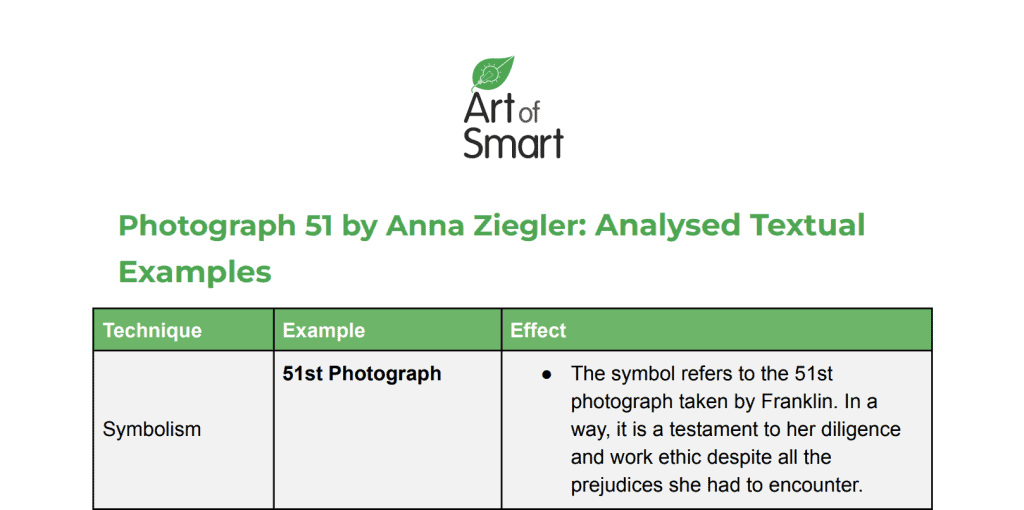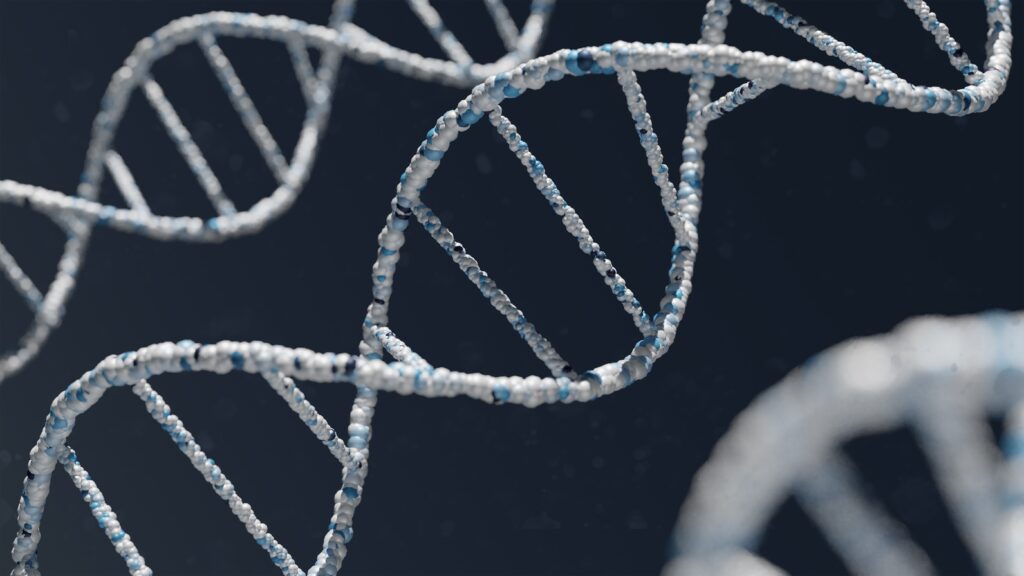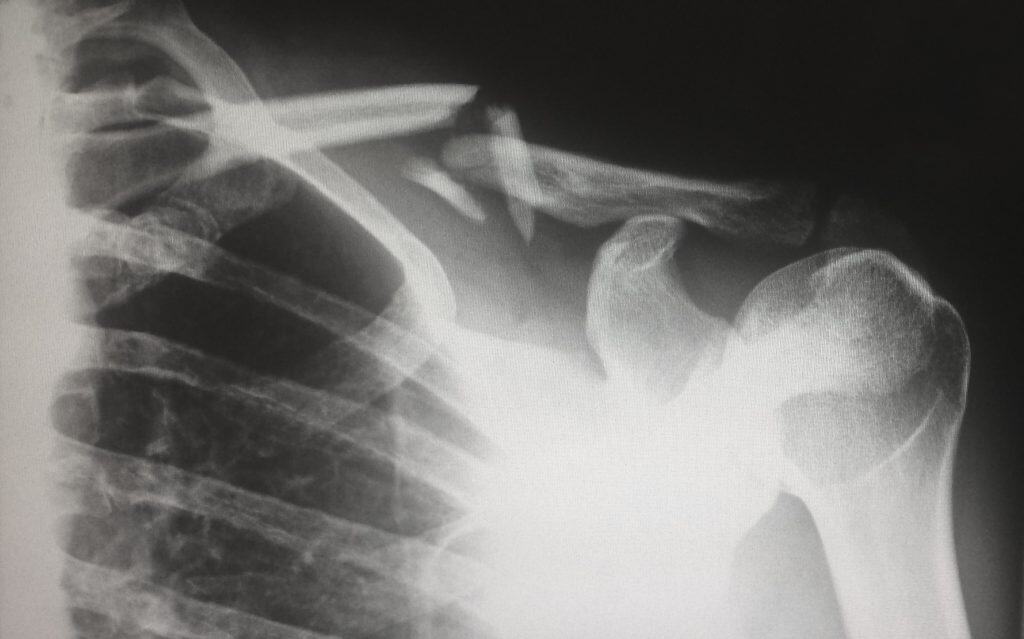Coming up with your analysis for ‘Photograph 51’ by Anna Ziegler?
You’ve come to the right place! Here is a summary of ‘Photograph 51’, along with its key themes and a step-by-step guide on how to break down the text.
We also threw in a FREE sample analysis table (also known as a TEE table) and a sample paragraph for you!
So, let’s go and ace your essay!
Summary of Photograph 51 by Anna Ziegler
Key Characters
Themes Explored in Photograph 51
Analysis of Photograph 51 by Anna Ziegler
Summary of Photograph 51 by Anna Ziegler
Rosalind Franklin, a British-Jewish accomplished scientist, is called to King’s College, London, to work on discovering the structure of DNA. To her dismay, she finds herself placed in an ‘assistant’ role to her colleague Maurice Wilkins, who refuses to address her as ‘Doctor’ and prefers ‘Rosy’ or ‘Miss Franklin’, despite her insistence of their work being a partnership rather than an boss-assistant dynamic.
Despite some light moments between the two, which includes them sharing a view of a performance of Shakespeare’s ‘A Winter’s Tale’, Wilkins manages to make Rosalind feel exploited and disrespected. Rosalind soon liaisons with Don Caspar, an American phd student in biophysics, also Jewish, to help with the research. Her actual assistant, Ray Gosling, warns Rosalind to be careful around the x-ray machine used for research, something that she does not do, and she exposes herself to x-rays time and again.
At a DNA lecture conference in Naples, Wilkins realises there is a “race” is happening to discover the structure of DNA, as he learns a researcher named Francis Crick and his American assistant, James Watson are also working on a DNA model. Wilkins thus pushes his team to press forward and beat his competitors.
Rosalind realises Wilkins is presenting their research abroad, taking most of the credit, while she is relegated to the lab. This infuriates her and pushes her to cut all ties with Wilkins. Out of spite, Wilkins joins his competitors in sabotaging Franklin’s lectures in London. He however realises the methods of his competitors are wrong when they hurriedly arrange an incorrect DNA model to discredit Rosalind.
Wilkins therefore jumps ships again back to his original team. Meanwhile, Gosling and Rosalind discover the helical structure of DNA through an x-ray image, the 51st image taken in the research, but hesitate in publishing their findings.
This is both due to the extensive trials needed for the scientific method, and because as a Jewish woman, Rosalind is pressured to ‘never be wrong’ by the scientific community and its prejudices. Caspar arrives at King’s College, while Gosling shows the picture to Wilkins out of impatience.
Despite this, Wilkins cannot maintain the secret of what he saw when approached by Watson and tempted to join their team out of spite towards Rosalind, who had rejected him multiple times. Wilkins shows the picture to his competitors.
Caspar is evidently infatuated with Rosalind, although this comes a bit too late. Rosalind discovers tumours in her ovaries, despite being overworked and exhausted, she carries on researching as her competitors work on their model.
Crick and Watson publish, with the former admitting his aversion to fame. Wilkins complains to Rosalind about their effective defeat in the race, yet she insists on carrying on working, and acknowledging the find as a victory for humanity. Despite her existence edging towards an end, she pulls herself together and arranges to be at the Leeds DNA conference the following month.
Sadly, Rosalind succumbs to her illness before she gets to Leeds. Wilkins breaks the fourth wall and commands to relive his first meeting with Rosalind. In a dramatic fashion he apologises for his mistreatment of her in a flashback, while she apologises for not having trusted to publish sooner.
At this moment, they are suspended in time and space. At last, they reminisce about the performance ‘The Winter’s Tale’ and try to recall the actress whose performance impressed Rosalind. They fail to do so and resort to the notion that “she simply didn’t stand out”.
Key Characters
Rosalind
Due to widespread sexism and antisemitism in the scientific scene at the time, the protagonist Rosalind has had to work hard and meticulously all her life to go head to head with male scientists, often unqualified compared to her. She has always preferred a solitary approach to her research due to sexism and fierce competition.
However, such isolation comes to bite her in the back as she is outpaced by her competitors when she is hospitalised for her illness, and ends up losing the Nobel Prize to Wilkins. In the final scenes, Rosalind comes to question the barriers and methods she has used to become successful, as these have also kept her from achieving ultimate success.
Wilkins
Referring to Rosalind without her academic titles, and often letting out racist and misogynistic comments, Wilkins sets himself up on the wrong side of both Rosalind and the audience. This is a grave mistake that stabs Wilkins later, when he regrets his inability to share more moments with Rosalind, and her superiority to other competitors.
In essence, Wilkins falls victim to the guilt of Rosalind losing the Nobel prize, something she was utterly deserving of receiving. He was part of why this happened.
Gosling
He is intelligent, caring, considerate, and ultimately an amazing friend to Rosalind, and ultimately elevates her work both in life and in death by underlining her role. This is ultimately due to the guilt he feels for showing the photograph without her permission.
He also serves to explore Rosalind’s vulnerabilities, as he is one of the few male characters she opens up to due to his caring nature.
Caspar
A vicious supporter of Rosalind, they bond over their ethnicity and experience. Unlike most men she encounters, Caspar does not downplay Rosalind’s intelligence, and does not feel intimidated by it.
He falls in love with it. Her death devastates him.
Watson
Perhaps the closest thing to a villain in the play, this young American scientist has no scruples when it comes to winning the DNA race, and exploits the vulnerabilities and friction between Wilkins and his team to get him to share the research with him.
His cruelty towards Rosalind is evident, as he sabotages her lectures by commenting on her physical appearances and mannerisms in a racist and pejorative way.
Themes Explored in Photograph 51
Unlike some plays, this one is firmly based on historical reality. While creative freedom was exercised in terms of developing scenes and dialogue, the overall sequence of events is based on a true story.
This great play can be classified as a piece of historical fiction, although Franklin’s death occurred 5 years after the 1953 publishing of Watson and Crick in real life, not before she began studying polio and RNA.
The competitive environment of the scientific community at the time is as faithful as the sexism and racism Franklin had to endure. Interestingly enough, Ziegler was originally planning to integrate an abbreviated version of the story in another comprehensive play about women in STEM.
The plan did not fall through, however, when she realised Franklin needed a stand alone play. This was due to Ziegler being fascinated with the conflicting nature of the protagonist’s character, and how her work ethic turned out to be her worst enemy and hindrance to the discovery.
Sexism in the 50s
Discrimination based on sex was very common in the 1950s. Women were largely expected to conform to gender roles and expectations, even in the most democratic societies at the time.
Unfortunately, science was heavily male-dominated, as many women were either forced or preferred prioritising marriage and family life to their career. Franklin is an exception, and because of this she is seen as lesser, or as an outsider to the scientific community.
She is constantly belittled by her academic equals and rivals, which makes sexism a prevalent source of struggle for the protagonist.
Not sure which techniques are best for analysing plays? Check out our Così analysis here!
Anti-semitism
We often forget about the anti-semitism with western societies. But despite this and World War 2 being a very recent memory, anti-semitism was rampant in Britain. Franklin repeatedly has to face slurs and derogatory expressions due to her ethnicity, even among professional scientists!
Not only is this a key theme, but it also emboldens the magnitude of Franklin’s achievements in her field, despite all such difficulties.
Fate VS Freewill
Franklin ultimately succumbs to her illness, which makes it heartbreaking when she does not win the DNA race and the Nobel Prize. Here, Ziegler shows the cold and cruel side of fate on the characters’ destinies.
Despite her will to work and her disobedience of medical precautions, Franklin gives her all for the final objective. But despite her ‘will’ to do everything possible and impossible, fate wins in the end. It is for the reader to decide what has more gravity in the story, fate or personal determination.
How to Analyse Photograph 51 by Anna Ziegler in 3 Steps
Step 1: Choose your example
The best way to choose an example is to choose a technique.
Remember you must include stylistic devices (how images and words are arranged in a text in order to produce meaning) and aesthetic features (elements that prompt a critical response from the reader) in your essays to gain the most marks.
In this case we will use the quote:
I don’t remember. I suppose she didn’t stand out.
You can check out a list of quotes from Photograph 51 here!
Step 2: Identify your technique(s)
This quote is packed with two techniques. One is an allusion to the Shakespearean play ‘A Winter’s Tale’, and the other is an Allegory, because Franklin and the protagonist of ‘A Winter’s Tale’ have mirrored qualities.
They are both heroines in their own ways — both protagonists and both face their battles as strong women. Unpacking these references is a great way to step up your analysis.
Step 3: Write the analysis
Always be ready to ask yourself what the author intended you to feel/respond emotionally by reading the example quote.
This will make sure that you tackle an important part of the analysis, which is the effect on the reader.
The masterful Anna Ziegler utilises both allusion and allegory to highlight the strength of her female lead in ‘Photograph 51’. Franklin, the protagonist responds “I don’t remember. I suppose she didn’t stand out…” when asked to recall the name of the lead actress in the Shakespearean production ‘A Winter’s Tale’. The quote in itself, “…she didn’t stand out” refers to the actress not being memorable in her performance, despite her being the lead character, an evident parallel to Franklin and her research. Hence, allegory and allusion are used to highlight the strength of the female lead of ‘Photograph 51’.
Need some help analysing other texts?
Check out other texts we’ve created guides for below:
- Things Fall Apart
- One Flew Over the Cuckoo’s Nest
- Fever 103
- Rhapsody on a Windy Night
- Nick and the Candlestick
- Little Miss Sunshine
- Frank Hurley: The Man Who Made History
- Mabo
- Macbeth
- Like a House on Fire
- Run Lola Run
- The Curious Incident of the Dog in the Night-Time
- King Lear
- Rainbow’s End
Are you looking for some extra help with your analysis of Photograph 51 by Anna Ziegler?
We have an incredible team of English tutors and mentors!
We can help you master your analysis of Photograph 51 by taking you through the summary, context and themes. We’ll also help you ace your upcoming English assessments with personalised lessons conducted one-on-one in your home or online!
We’ve supported over 8,000 students over the last 11 years, and on average our students score mark improvements of over 20%!
Give us a ring on 1300 267 888, email us at [email protected] or check us out on TikTok!
Vittorio Manessi is an Art of Smart tutor based in Queensland studying environmental science. He was one of the first Year 12 students to study under the new ATAR system in Queensland. He enjoys Maths, Science, English and Ancient History and is keen to share his knowledge of the QCE by making awesome resources.







